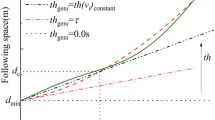Abstract
This manuscript introduces a new robust control design of car active suspension systems using ellipsoidal techniques. The impact of road irregularities is regarded as an external disturbance. The suggested controller meets the following objectives: optimal passenger comfort, actuator control force limit satisfaction, effective disturbance rejection, and robustness against changes in passengers’ load. The passenger load variations cause system uncertainty that is modeled as norm-bounded. A new sufficient condition is established based on the invariant ellipsoid method and the linear matrix inequalities optimization to guarantee robust stability and performance for the system. Time-domain model of road roughness based on trigonometric functions is studied. The performance of the proposed controller is tested using a quarter-car model with an active suspension system. Comparative simulation with other techniques, e.g., H∞ and regional pole placement, is given. Actuator dynamics and system nonlinearities are modeled and included in the design at the end.







Similar content being viewed by others
References
Cao, D.; Song, X.; Ahmadian, M.: Editors’ perspectives: road vehicle suspension design, dynamics, and control. Veh. Syst. Dyn. 49, 3–28 (2011)
Tseng, H.E.; Hrovat, D.: State of the art survey: active and semi-active suspension control. Veh. Syst. Dyn. 53, 1034–1062 (2015)
Fallah, M.; Bhat, R.B.; Xie, W.F.: Optimized control of semi-active suspension systems using H∞ robust control theory and current signal estimation. IEEE/ASME Trans. Mechatron. 17, 767–778 (2012)
Verros, G.; Natsiavas, S.; Papadimitriou, C.: Design optimization of quarter-car models with passive and semi-active suspensions under random road excitation. J. Vib. Control 11, 581–606 (2005)
Soliman, H.M.; Awadallah, M.A.; NadimEmira, M.: Robust controller design for active suspensions using particle swarm optimization. Int. J. Model. Identif. Control 5, 66–76 (2008)
Yagiz, N.; Hacioglu, Y.: Backstepping control of a vehicle with active suspensions. Control Eng. Pract. 16, 1457–1467 (2008)
Zuo, L.; Slotine, J.J.; Nayfeh, S.A.: Model reaching adaptive control for vibration isolation. IEEE Trans. Control Syst. 13, 611–617 (2005)
Huang, S.-J.; Chao, H.-C.: Fuzzy logic controller for a vehicle active suspension system. Proc. Inst. Mech. Eng. Part D J. Automob. Eng. 214, 1–12 (2000)
Soliman, H.M.; Bajabaa, N.: Robust guaranteed-cost control with regional pole placement of active suspensions. J. Vib. Control 19, 1170–1186 (2013)
Soliman, H.M.; Benzaouia, A.; Yousef, H.: Saturated robust control with regional pole placement and application to car active suspension. J. Vib. Control 22, 258–269 (2016)
Soliman, H.M., Al-Abri, R., Albadi, M.: Design of robust digital pole placer for car active suspension with input constraint, chapter 2. In: Vibration Analysis and Control in Mechanical Structures and Wind Energy Conversion Systems (2018). https://doi.org/10.5772/intechopen.70587
Onat, C.; Kucukdemiral, I.; Sivrioglu, S.; Cansever, Y.G.: LPV gain scheduling controller design for a non-linear quarter-vehicle active suspension system. Trans. Inst. Meas. Control 31, 71–95 (2009)
Chen, H.; Guo, K.: Constrained H∞ control of active suspensions: an LMI approach. IEEE Trans. Control Syst. Technol. 13, 412–421 (2005)
Li, H.; Jing, X.; Karimi, H.R.: Output-feedback-based H∞ control for vehicle suspension systems with control delay. IEEE Trans. Ind. Electron. 61, 436–446 (2014)
Akbari, A.; Lohmann, B.: Output feedback HN/GH2 preview control of active vehicle suspensions: a comparison study of LQG preview. Veh. Syst. Dyn. 48, 1475–1494 (2010)
Polyak, B.T.; Topunov, M.V.: Suppression of bounded exogenous disturbances: output feedback. Autom. Remote Control 69, 801–818 (2008)
Blanchini, F.; Miani, S.: Set-Theoretic Methods in Control. Birkhauser, Basel (2008)
Dahleh, M.A.; Pearson, J.B.: L1-optimal feedback controllers for MIMO discrete-time systems. IEEE Trans. Autom. Control 32, 314–322 (1987)
Du, H.; Zhang, N.: Fuzzy control for nonlinear uncertain electro-hydraulic active suspensions with input constraint. IEEE Trans. Fuzzy Syst. 17, 343–356 (2009)
Vaddi, P.K.R.; Kumar, C.S.: A non-linear vehicle dynamics model for an accurate representation of suspension kinematics. Proc. IMech. E Part C J. Mech. Eng. Sci. 229(6), 1002–1014 (2015)
Boyd, S.; El Ghaoui, L.; Feron, E.; Balakrishnan, V.: Linear Matrix Inequalities in System and Control Theory. Society for Industrial and Applied Mathematics, Philadelphia (1994)
Author information
Authors and Affiliations
Corresponding author
Appendix
Appendix
Proof of Theorem 2
The original minimization problem in terms of the ellipsoid \({\mathcal{E}}_{z} = z^{\prime } P^{ - 1} z, z = \left( {C + DK} \right)x\) can be written as
Subject to (9).
The matrix Eq. (9) is nonlinear in the variables K, and P. To linearize it, the following new matrix is introduced
Hence, (9) reduces to
The objective function (A1) to be minimized is rewritten as
Equation (A4) is nonlinear in Y. To reduce it to minimizing a linear function, another matrix is introduced as follows.
Minimizing \(J \left( {P, Y} \right)\) is equivalent to minimizing (13) subject to (15).
To include system uncertainty, the matrices \(A, B\) are replaced by \(A + \Delta A\), \(B + \Delta B\), respectively, in (A3) to get (12). Applying the Schur complement \(\varPsi \Delta \left( t \right)\varPhi + *\left\langle {\varepsilon \varPsi \varPsi^{\prime } + \varepsilon^{ - 1} \varPhi^{\prime } \varPhi ,\varepsilon } \right\rangle 0\) [21] to eliminate the uncertainty matrices Δ(t), Theorem 2 is obtained.
Rights and permissions
About this article
Cite this article
Soliman, H.M., El-Metwally, K. & Soliman, M. Invariant Sets in Saturated and Robust Vehicle Suspension Control. Arab J Sci Eng 45, 7055–7064 (2020). https://doi.org/10.1007/s13369-020-04703-3
Received:
Accepted:
Published:
Issue Date:
DOI: https://doi.org/10.1007/s13369-020-04703-3




